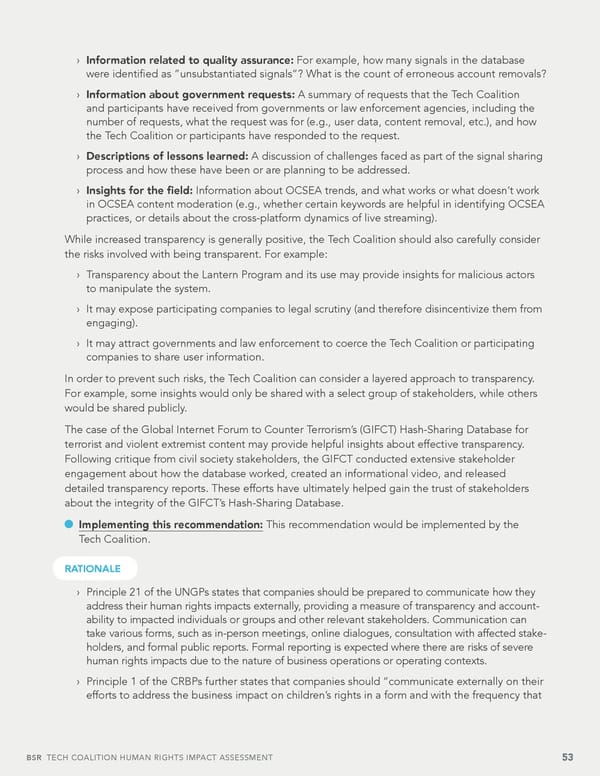› Information related to quality assurance: For example, how many signals in the database were identi昀椀ed as “unsubstantiated signals”? What is the count of erroneous account removals? › Information about government requests: A summary of requests that the Tech Coalition and participants have received from governments or law enforcement agencies, including the number of requests, what the request was for (e.g., user data, content removal, etc.), and how the Tech Coalition or participants have responded to the request. › Descriptions of lessons learned: A discussion of challenges faced as part of the signal sharing process and how these have been or are planning to be addressed. › Insights for the 昀椀eld: Information about OCSEA trends, and what works or what doesn’t work in OCSEA content moderation (e.g., whether certain keywords are helpful in identifying OCSEA practices, or details about the cross-platform dynamics of live streaming). While increased transparency is generally positive, the Tech Coalition should also carefully consider the risks involved with being transparent. For example: › Transparency about the Lantern Program and its use may provide insights for malicious actors to manipulate the system. › It may expose participating companies to legal scrutiny (and therefore disincentivize them from engaging). › It may attract governments and law enforcement to coerce the Tech Coalition or participating companies to share user information. In order to prevent such risks, the Tech Coalition can consider a layered approach to transparency. For example, some insights would only be shared with a select group of stakeholders, while others would be shared publicly. The case of the Global Internet Forum to Counter Terrorism’s (GIFCT) Hash-Sharing Database for terrorist and violent extremist content may provide helpful insights about effective transparency. Following critique from civil society stakeholders, the GIFCT conducted extensive stakeholder engagement about how the database worked, created an informational video, and released detailed transparency reports. These efforts have ultimately helped gain the trust of stakeholders about the integrity of the GIFCT’s Hash-Sharing Database. Implementing this recommendation: This recommendation would be implemented by the Tech Coalition. RATIONALE › Principle 21 of the UNGPs states that companies should be prepared to communicate how they address their human rights impacts externally, providing a measure of transparency and account- ability to impacted individuals or groups and other relevant stakeholders. Communication can take various forms, such as in-person meetings, online dialogues, consultation with affected stake- holders, and formal public reports. Formal reporting is expected where there are risks of severe human rights impacts due to the nature of business operations or operating contexts. › Principle 1 of the CRBPs further states that companies should “communicate externally on their efforts to address the business impact on children’s rights in a form and with the frequency that BSR TECH COALITION HUMAN RIGHTS IMPACT ASSESSMENT 53
 Tech Coalition Human Rights Impact Assessment of the Lantern Program Page 52 Page 54
Tech Coalition Human Rights Impact Assessment of the Lantern Program Page 52 Page 54